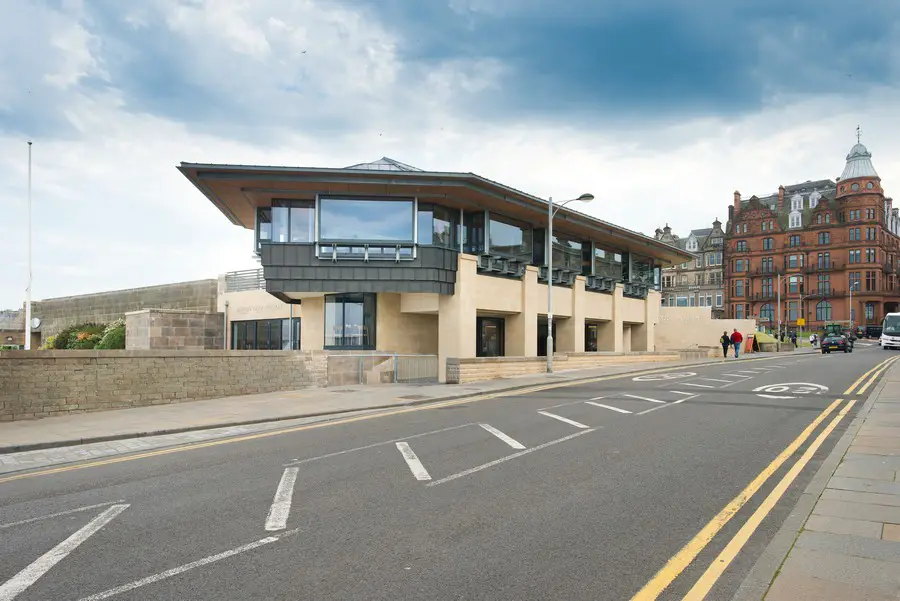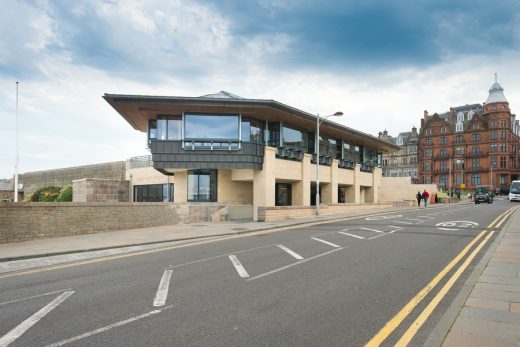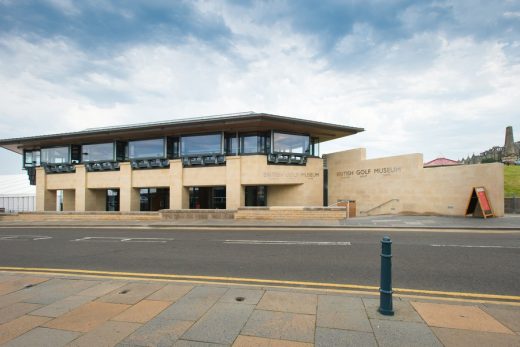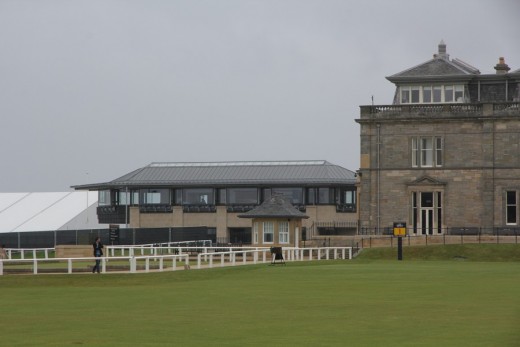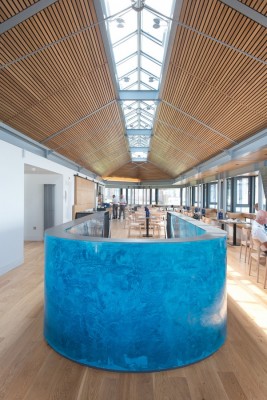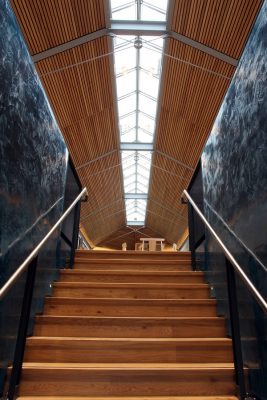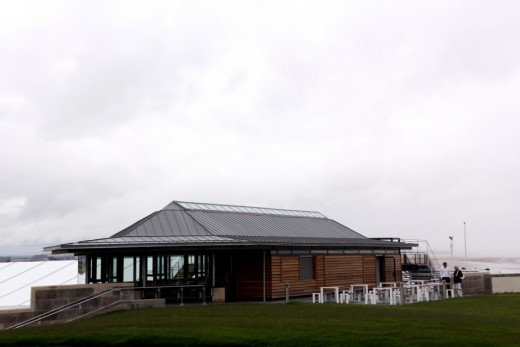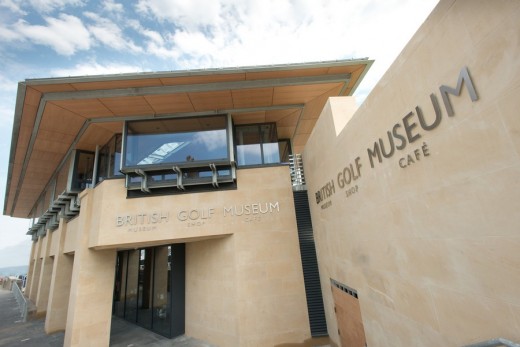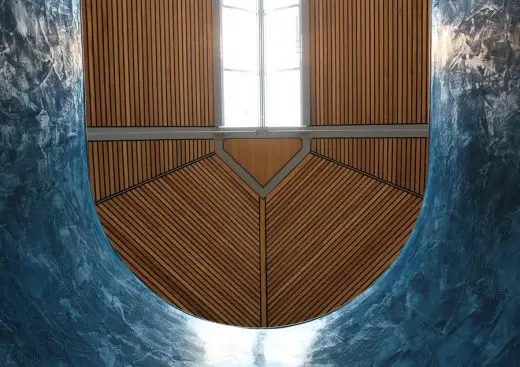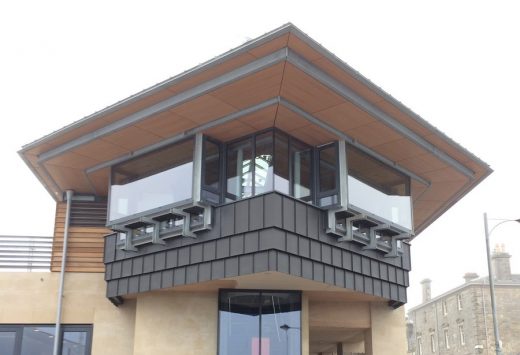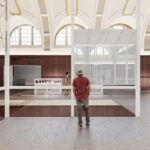British Golf Museum and Cafe, St Andrews Building, Old Course Scotland, Project Design Images
British Golf Museum and Cafe, Fife
New St Andrews Building in Fife, Scotland design by Richard Murphy Architects
page updated 23 Sep 2016 with new photos ; 6 Jul 2015
British Golf Museum and Cafe in St Andrews
Design: Richard Murphy Architects
New British Golf Museum and Cafe at the home of golf in St Andrews
Richard Murphy Architects has completed a major transformation of the British Golf Museum in St Andrews. The new first floor space contains an 80 seat cafe, with panoramic views taking in the 1st tee of the world famous Old Course and West Sands beach, and a new outdoor dining terrace on the Bruce Embankment.
The Museum entrance facade has been given a more commanding presence, while the shop and reception have been remodelled on the ground floor, with the 16,000 items on display in the Museum awaiting visitors once again in a more contemporary setting.
Bill Black, Director at Richard Murphy Architects said “It has been an honour to design a building next to one of the oldest and most iconic golf courses in the world.
The design is conceived as a simple pavilion in the landscape and takes something from the language of the existing bandstand, the other golf pavilions and beachfront buildings in general.
The orientation of the cafe has been key to the design, maximising the views across the Old Course for the cafe visitors, whilst leaving uninterrupted views to the beach beyond for the adjacent existing buildings at the edge of the town.”
The British Golf Museum opened to the public in 1990 and the five star Museum welcomes more than 60,000 visitors each year. It is situated directly opposite the grade A listed Royal and Ancient Clubhouse, built in 1854, at The Old Course in St Andrews, one of the oldest golf courses in the world with play dating back to the 1400’s.
The Museum holds the most comprehensive golf collection in Europe and one of the finest worldwide, telling the story of golf from the 17th century to the present day, but was lacking social space for visitors to relax and enjoy refreshments.
Angela Howe, Museum & Heritage Director commented: “The café, the re-designed galleries and shop herald a new chapter in the Museum’s history and we are excited by the direction we are going in. The building has been transformed from a semi-hidden bunker to an elegant addition to the landscape. The Museum has a stronger presence, which we hope will appeal to visitors and the local community.’’
The Open has been played since 1860 and will take place over the Old Course in St Andrews from 16-19 July 2015, and the building may just be visible from televised coverage at the 1st tee.
British Golf Museum and Cafe – Building Information
Architects: Richard Murphy Architects
Location: St Andrews, Scotland
Type Of Project: New Cafe and other alterations at the British Golf Museum
Project Director: Bill Black
Client: The British Golf Museum
Gross internal floor area: New build floor area 253m² modified area of existing floor 327m². Total 580m²
Form of contract: Traditional
Total cost: Approximately £2m
Structural Engineers: David Narro Associates
M&E engineers: WSP Parsons Brinckerhoff
Quantity surveyor: Morham & Brotchie Ltd
British Golf Museum and Cafe in St Andrews images / information from Richard Murphy Architects, Edinburgh, Scotland
RIAS Awards / RIBA Awards for Scotland 2016 shortlisted
Location: British Golf Museum, St Andrews, Fife, Scotland
Scottish Architecture Design – chronological list
St Andrews Buildings
St Andrews Medical School Building
Design: Reiach and Hall Architects
St Andrews Medical School Building
St Andrews University Building
Design: Reiach and Hall Architects
St Andrews Building
Best Building in Scotland : Doolan Prize winners news
Byre Theatre Fife
Design: Nicoll Russell Studios
Scottish Architecture – Selection
V&A Dundee
V&A Dundee Building
Justice Mill Lane, Aberdeen
Justice Mill Lane Building : Richard Murphy Architects
Comments / photos for the British Golf Museum and Cafe in St Andrews page welcome
Website: Richard Murphy Architects

